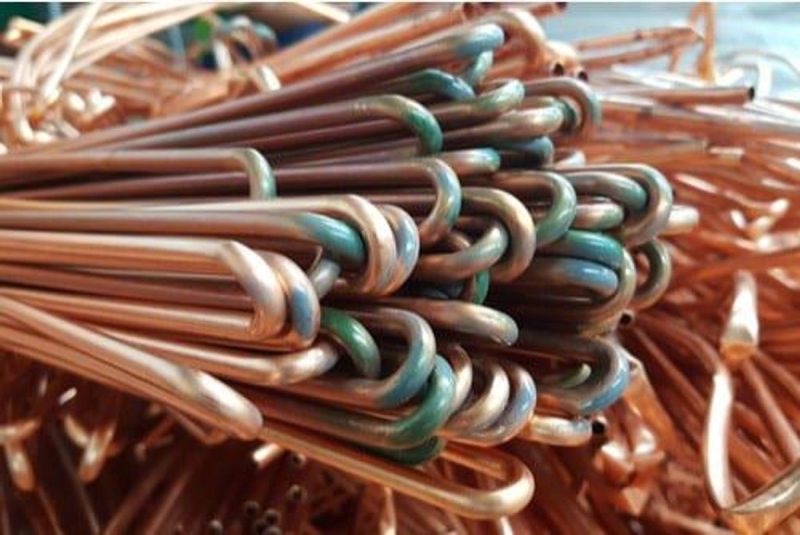Copper is one of the most important materials in our everyday life, and copper scrap material represents a strategic source of the crucial base metal.
Copper is widely used in building construction, electrical grids, electronic products, transportation equipment and home appliances. Rising demand for renewable energy, electric vehicles and high-tech products bodes well for copper, as it has the highest conductivity of any metal apart from silver, making it ideal for the green economy.
Recycled copper scrap contributes significantly to supply, and plays a behind-the-scenes role in balancing the market. ‘Copper’s recycling value is so great that premium-grade scrap normally has at least 95 (percent) of the value of the primary metal from newly mined ore,’ states a report from the Copper Development Association.
What’s more, scrap has been referred to as ‘the world’s largest copper mine,’ and perhaps the most responsive as well, given producers’ ability to source more or less depending on prices. Read on to learn about this material and its impact on the global copper market.
What is copper scrap?
As with many metals, copper is 100 percent recyclable and for the most part retains its wide variety of beneficial properties when it is reused. Copper scrap material — also known as secondary copper — can be divided into two main categories: new scrap and old scrap.
New scrap is copper metal discarded in fabrication and manufacturing processes and is typically considered higher-grade material than old scrap. Old scrap refers to copper wire, copper tubing, roofing copper or copper pipe from post-consumer products that can be converted to refined metal and alloys.
During the recycling process, these secondary copper materials are smelted in furnaces and then further processed and refined. Electrical applications require high-grade copper, and while newly mined copper is often preferred for this purpose, premium-quality new scrap material can be used as well. Recycled copper for use in non-electrical applications, such as plumbing tubes or roofing sheets, is often old scrap.
Scrap metal recycling aids the environment in many ways, such as by reducing energy use, greenhouse gas emissions and landfill waste. Indeed, the International Copper Study Group notes that one computer contains around 1.5 kilograms (3.3 pounds) of copper; a typical home can contain as much as 100 kilograms (220 pounds).
According to the group, recycling copper requires 85 percent less energy than primary copper production at the mine level. On a global level, copper recycling reduces electrical energy use by 100 million megawatt hours and keeps 40 million metric tons (MT) of carbon dioxide out of the atmosphere on an annual basis.
What are the copper scrap market’s key players?
Copper scrap meets about 32 percent of total global copper demand, as per the International Copper Association. Percentages vary by region, though — in Europe, recycled copper accounts for about 50 percent of all copper use.
China, which makes up around 55 percent of global copper consumption, is also the world’s largest refiner of copper from scrap material. Secondary copper production in China has averaged more than 1.5 million MT per year for the last decade, equal to about 30 percent of the nation’s total copper consumption.
Much of that secondary copper comes from imports, largely from the US (18 percent) and Japan (14 percent). In 2022, China reportedly imported 1.77 million MT of high-purity copper scrap material.
This figure is an increase of about 80,000 MT from 2021 as the market recovers from a steep drop in recent years. In comparison, the country imported 2.4 million MT of copper scrap material in 2018. The dramatic slide in copper imports was reflective of China’s restrictions on scrap metal imports, including copper, as part of its fight against environmental pollution.
The restrictions were introduced as a prelude to a planned outright ban on imports of what China calls ‘foreign garbage’ that was intended to go into effect in 2020. However, the COVID-19 pandemic and a lack of clarity from the country’s government created confusion about the path forward.
Explaining the situation at the time, Bloomberg stated that China’s restrictions on copper scrap imports ‘forced the country’s highly lucrative processing industry to move overseas.’ Unfortunately, that happened alongside renewed demand for copper in China and the COVID-19 outbreak, which disrupted both primary and secondary copper supply lines at a global level.
As Research and Markets reported, the pandemic created a shortage of copper scrap metal. The COVID-19-induced supply gap, along with intense pressure from the nation’s copper scrap recyclers, led China to exempt high-grade copper scrap imports from the waste ban, reclassifying them as ‘resources.’ The Chinese government also suspended its 25 percent tax on US copper scrap imports. The policy change with a focus on higher-grade recyclable materials boosted imports by 80 percent to 1.7 million MT in 2021.
Indonesia and Malaysia have also ’emerged as major recycling hubs, reexporting a cleaner material to China,’ as per S&P Global Market Intelligence. ‘The two countries have recently been working toward new guidelines for metals scrap imports on concern over the processing of materials bearing copper and other elements.’ In 2022, Malaysia was the third largest import source for copper to China, accounting for 12 percent of total imports.
What’s the outlook for the copper scrap market?
Copper is a key material in many industries, and undersupply issues in the global copper market are nothing new — in fact, calls for peak copper have been made for more than a decade.
Where there’s demand and a lack of supply, there’s a need for scrap copper. This material will continue to play an important role in the overall copper market, especially in times when primary copper mines experience disruption or when they are simply not producing enough of the metal to feed demand.
Securities Disclosure: I, Melissa Pistilli, hold no direct investment interest in any company mentioned in this article.

